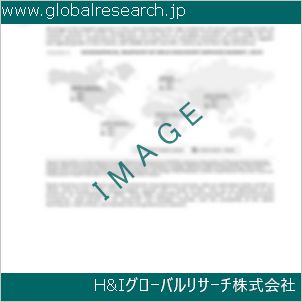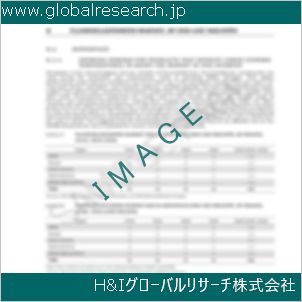1 市場概要
1.1 製品概要と範囲
1.2 市場推定の注意点と基準年
1.3 タイプ別市場分析
1.3.1 概要:グローバルUV保護繊維および糸の消費価値(タイプ別):2020年対2024年対2031年
1.3.2 反射タイプ
1.3.3 吸収タイプ
1.4 用途別市場分析
1.4.1 概要:グローバルUV保護繊維および糸の消費額(用途別):2020年対2024年対2031年
1.4.2 家庭用テキスタイル
1.4.3 傘
1.4.4 テント
1.4.5 産業用保護製品
1.4.6 その他
1.5 グローバルUV保護繊維および糸市場規模と予測
1.5.1 グローバルUV保護繊維および糸の消費額(2020年、2024年、2031年)
1.5.2 グローバルUV保護繊維および糸の販売数量(2020年~2031年)
1.5.3 グローバルUV保護繊維および糸の平均価格(2020年~2031年)
2 メーカープロファイル
2.1 Unifi
2.1.1 Unifiの詳細
2.1.2 Unifiの主要事業
2.1.3 Unifi UV保護繊維および糸の製品とサービス
2.1.4 Unifi UV保護繊維および糸の売上数量、平均価格、売上高、粗利益率、市場シェア(2020-2025)
2.1.5 Unifiの最近の動向/更新
2.2 RadiciGroup
2.2.1 RadiciGroupの詳細
2.2.2 RadiciGroupの主要事業
2.2.3 RadiciGroup UV保護繊維および糸の製品とサービス
2.2.4 RadiciGroup UV保護繊維および糸の売上数量、平均価格、売上高、粗利益率、市場シェア(2020-2025)
2.2.5 RadiciGroupの最近の動向/更新
2.3 アジア太平洋地域繊維
2.3.1 アジア太平洋地域繊維の詳細
2.3.2 アジア太平洋地域繊維の主要事業
2.3.3 アジア太平洋地域繊維 UV保護繊維および糸の製品とサービス
2.3.4 アジア太平洋地域繊維 UV保護繊維および糸の販売数量、平均価格、売上高、粗利益率、市場シェア(2020-2025)
2.3.5 アジア太平洋地域繊維の最近の動向/更新情報
2.4 TWD ファイバーズ
2.4.1 TWDファイバーズの詳細
2.4.2 TWD繊維の主要事業
2.4.3 TWD繊維 UV保護繊維および糸の製品とサービス
2.4.4 TWDファイバーズ UV保護繊維および糸の販売数量、平均価格、売上高、粗利益率、市場シェア(2020-2025)
2.4.5 TWD Fibres の最近の動向/更新
2.5 クラレ
2.5.1 クラレの概要
2.5.2 クラレ主要事業
2.5.3 クラレ UV保護繊維および糸の製品とサービス
2.5.4 クラレ UV保護繊維および糸の売上数量、平均価格、売上高、粗利益率、市場シェア(2020-2025)
2.5.5 クラレの最近の動向/更新
2.6 フリーデンベルグ パフォーマンス マテリアルズ
2.6.1 フリーデンベルグ パフォーマンス マテリアルズの詳細
2.6.2 フリーデンベルグ パフォーマンス マテリアルズ 主な事業
2.6.3 フリーデンベルグ パフォーマンス マテリアルズ UV保護繊維および糸の製品とサービス
2.6.4 フリーデンベルグ パフォーマンス マテリアルズ UV保護繊維および糸の売上数量、平均価格、売上高、粗利益率、市場シェア(2020-2025)
2.6.5 フリーデンベルク パフォーマンス マテリアルズの最近の動向/更新
3 競争環境:UV保護繊維および糸(メーカー別)
3.1 グローバルUV保護繊維および糸の製造業者別販売数量(2020-2025)
3.2 グローバルUV保護繊維および糸の売上高(メーカー別)(2020-2025)
3.3 グローバルUV保護繊維および糸の平均価格(メーカー別)(2020-2025)
3.4 市場シェア分析(2024年)
3.4.1 製造メーカー別UV保護繊維・糸の出荷量(売上高:$MM)と市場シェア(%):2024
3.4.2 2024年のUV保護繊維および糸の主要3メーカーの市場シェア
3.4.3 2024年のUV保護繊維および糸の製造業者別市場シェア(上位6社)
3.5 UV保護繊維および糸市場:全体的な企業足跡分析
3.5.1 UV保護繊維および糸市場:地域別足跡
3.5.2 UV保護繊維および糸市場:企業製品タイプ別足跡
3.5.3 UV保護繊維および糸市場:企業製品用途別足跡
3.6 新規参入企業と市場参入障壁
3.7 合併、買収、契約、および提携
4 地域別消費分析
4.1 地域別グローバルUV保護繊維および糸市場規模
4.1.1 地域別UV保護繊維および糸のグローバル販売数量(2020-2031)
4.1.2 地域別UV保護繊維および糸の消費額(2020-2031)
4.1.3 地域別UV保護繊維および糸の平均価格(2020-2031年)
4.2 北米 UV保護繊維および糸の消費額(2020-2031)
4.3 欧州の紫外線保護繊維および糸の消費額(2020-2031)
4.4 アジア太平洋地域 UV保護繊維および糸の消費額(2020-2031)
4.5 南米 UV保護繊維および糸の消費額(2020-2031)
4.6 中東・アフリカ UV保護繊維および糸の消費額(2020-2031)
5 市場セグメント別(タイプ別)
5.1 グローバルUV保護繊維および糸の売上数量(タイプ別)(2020-2031)
5.2 グローバルUV保護繊維および糸の消費額(種類別)(2020-2031)
5.3 グローバルUV保護繊維および糸の平均価格(種類別)(2020-2031)
6 用途別市場セグメント
6.1 グローバルUV保護繊維および糸の用途別販売数量(2020-2031)
6.2 グローバルUV保護繊維および糸の用途別消費額(2020-2031)
6.3 グローバルUV保護繊維および糸の用途別平均価格(2020-2031)
7 北米
7.1 北米 UV保護繊維および糸の売上数量(タイプ別)(2020-2031)
7.2 北米 UV保護繊維および糸の売上数量(用途別)(2020-2031)
7.3 北米 UV保護繊維および糸の市場規模(国別)
7.3.1 北米 UV保護繊維および糸の売上数量(国別)(2020-2031)
7.3.2 北米 UV保護繊維および糸の消費額(国別)(2020-2031)
7.3.3 アメリカ市場規模と予測(2020-2031)
7.3.4 カナダ市場規模と予測(2020-2031)
7.3.5 メキシコ市場規模と予測(2020-2031)
8 ヨーロッパ
8.1 欧州 UV保護繊維および糸のタイプ別販売数量(2020-2031)
8.2 欧州のUV保護繊維および糸の売上数量(用途別)(2020-2031)
8.3 欧州 UV保護繊維および糸の市場規模(国別)
8.3.1 欧州のUV保護繊維および糸の売上数量(国別)(2020-2031)
8.3.2 欧州 UV 保護繊維および糸の消費額(国別)(2020-2031)
8.3.3 ドイツ市場規模と予測(2020-2031)
8.3.4 フランス市場規模と予測(2020-2031)
8.3.5 イギリス市場規模と予測(2020-2031)
8.3.6 ロシア市場規模と予測(2020-2031)
8.3.7 イタリア市場規模と予測(2020-2031)
9 アジア太平洋
9.1 アジア太平洋地域 UV保護繊維および糸の売上数量(種類別)(2020-2031)
9.2 アジア太平洋地域 UV保護繊維および糸の売上数量(用途別)(2020-2031)
9.3 アジア太平洋地域 UV保護繊維および糸の市場規模(地域別)
9.3.1 アジア太平洋地域 UV保護繊維および糸の地域別販売数量(2020-2031)
9.3.2 アジア太平洋地域 UV保護繊維および糸の地域別消費額(2020-2031)
9.3.3 中国市場規模と予測(2020-2031)
9.3.4 日本市場規模と予測(2020-2031)
9.3.5 韓国市場規模と予測(2020-2031)
9.3.6 インド市場規模と予測(2020-2031)
9.3.7 東南アジア市場規模と予測(2020-2031)
9.3.8 オーストラリア市場規模と予測(2020-2031)
10 南米
10.1 南米 UV保護繊維および糸の売上数量(種類別)(2020-2031)
10.2 南米 UV保護繊維および糸の売上数量(用途別)(2020-2031)
10.3 南米 UV保護繊維および糸の市場規模(国別)
10.3.1 南米 UV保護繊維および糸の売上数量(国別)(2020-2031)
10.3.2 南米 UV保護繊維および糸の消費額(国別)(2020-2031)
10.3.3 ブラジル市場規模と予測(2020-2031)
10.3.4 アルゼンチン市場規模と予測(2020-2031)
11 中東・アフリカ
11.1 中東・アフリカ UV保護繊維および糸のタイプ別販売数量(2020-2031)
11.2 中東・アフリカ UV保護繊維および糸の売上数量(用途別)(2020-2031)
11.3 中東・アフリカ UV保護繊維および糸の市場規模(国別)
11.3.1 中東・アフリカ UV保護繊維および糸の売上数量(国別)(2020-2031)
11.3.2 中東・アフリカ地域 UV保護繊維・糸の消費額(国別)(2020-2031)
11.3.3 トルコ市場規模と予測(2020-2031)
11.3.4 エジプト市場規模と予測(2020-2031)
11.3.5 サウジアラビア市場規模と予測(2020-2031)
11.3.6 南アフリカ市場規模と予測(2020-2031)
12 市場動向
12.1 UV保護繊維および糸市場ドライバー
12.2 UV保護繊維および糸市場の制約要因
12.3 UV保護繊維および糸のトレンド分析
12.4 ポーターの5つの力分析
12.4.1 新規参入の脅威
12.4.2 供給者の交渉力
12.4.3 購入者の交渉力
12.4.4 代替品の脅威
12.4.5 競争の激化
13 原材料と産業チェーン
13.1 UV保護繊維および糸の原材料と主要メーカー
13.2 UV保護繊維および糸の製造コストの割合
13.3 UV保護繊維および糸の製造プロセス
13.4 産業バリューチェーン分析
14 流通チャネル別出荷量
14.1 販売チャネル
14.1.1 直接エンドユーザー向け
14.1.2 卸売業者
14.2 UV保護繊維および糸の主要な卸売業者
14.3 UV保護繊維および糸の主要な顧客
15 研究結果と結論
16 付録
16.1 方法論
16.2 研究プロセスとデータソース
16.3 免責事項
1.1 Product Overview and Scope
1.2 Market Estimation Caveats and Base Year
1.3 Market Analysis by Type
1.3.1 Overview: Global UV Protection Fibers and Yarns Consumption Value by Type: 2020 Versus 2024 Versus 2031
1.3.2 Reflection Type
1.3.3 Absorption Type
1.4 Market Analysis by Application
1.4.1 Overview: Global UV Protection Fibers and Yarns Consumption Value by Application: 2020 Versus 2024 Versus 2031
1.4.2 Home Textiles
1.4.3 Umbrella
1.4.4 Tent
1.4.5 Industrial Protective Products
1.4.6 Others
1.5 Global UV Protection Fibers and Yarns Market Size & Forecast
1.5.1 Global UV Protection Fibers and Yarns Consumption Value (2020 & 2024 & 2031)
1.5.2 Global UV Protection Fibers and Yarns Sales Quantity (2020-2031)
1.5.3 Global UV Protection Fibers and Yarns Average Price (2020-2031)
2 Manufacturers Profiles
2.1 Unifi
2.1.1 Unifi Details
2.1.2 Unifi Major Business
2.1.3 Unifi UV Protection Fibers and Yarns Product and Services
2.1.4 Unifi UV Protection Fibers and Yarns Sales Quantity, Average Price, Revenue, Gross Margin and Market Share (2020-2025)
2.1.5 Unifi Recent Developments/Updates
2.2 RadiciGroup
2.2.1 RadiciGroup Details
2.2.2 RadiciGroup Major Business
2.2.3 RadiciGroup UV Protection Fibers and Yarns Product and Services
2.2.4 RadiciGroup UV Protection Fibers and Yarns Sales Quantity, Average Price, Revenue, Gross Margin and Market Share (2020-2025)
2.2.5 RadiciGroup Recent Developments/Updates
2.3 Asia Pacific Fibers
2.3.1 Asia Pacific Fibers Details
2.3.2 Asia Pacific Fibers Major Business
2.3.3 Asia Pacific Fibers UV Protection Fibers and Yarns Product and Services
2.3.4 Asia Pacific Fibers UV Protection Fibers and Yarns Sales Quantity, Average Price, Revenue, Gross Margin and Market Share (2020-2025)
2.3.5 Asia Pacific Fibers Recent Developments/Updates
2.4 TWD Fibres
2.4.1 TWD Fibres Details
2.4.2 TWD Fibres Major Business
2.4.3 TWD Fibres UV Protection Fibers and Yarns Product and Services
2.4.4 TWD Fibres UV Protection Fibers and Yarns Sales Quantity, Average Price, Revenue, Gross Margin and Market Share (2020-2025)
2.4.5 TWD Fibres Recent Developments/Updates
2.5 Kuraray
2.5.1 Kuraray Details
2.5.2 Kuraray Major Business
2.5.3 Kuraray UV Protection Fibers and Yarns Product and Services
2.5.4 Kuraray UV Protection Fibers and Yarns Sales Quantity, Average Price, Revenue, Gross Margin and Market Share (2020-2025)
2.5.5 Kuraray Recent Developments/Updates
2.6 Freudenberg Performance Materials
2.6.1 Freudenberg Performance Materials Details
2.6.2 Freudenberg Performance Materials Major Business
2.6.3 Freudenberg Performance Materials UV Protection Fibers and Yarns Product and Services
2.6.4 Freudenberg Performance Materials UV Protection Fibers and Yarns Sales Quantity, Average Price, Revenue, Gross Margin and Market Share (2020-2025)
2.6.5 Freudenberg Performance Materials Recent Developments/Updates
3 Competitive Environment: UV Protection Fibers and Yarns by Manufacturer
3.1 Global UV Protection Fibers and Yarns Sales Quantity by Manufacturer (2020-2025)
3.2 Global UV Protection Fibers and Yarns Revenue by Manufacturer (2020-2025)
3.3 Global UV Protection Fibers and Yarns Average Price by Manufacturer (2020-2025)
3.4 Market Share Analysis (2024)
3.4.1 Producer Shipments of UV Protection Fibers and Yarns by Manufacturer Revenue ($MM) and Market Share (%): 2024
3.4.2 Top 3 UV Protection Fibers and Yarns Manufacturer Market Share in 2024
3.4.3 Top 6 UV Protection Fibers and Yarns Manufacturer Market Share in 2024
3.5 UV Protection Fibers and Yarns Market: Overall Company Footprint Analysis
3.5.1 UV Protection Fibers and Yarns Market: Region Footprint
3.5.2 UV Protection Fibers and Yarns Market: Company Product Type Footprint
3.5.3 UV Protection Fibers and Yarns Market: Company Product Application Footprint
3.6 New Market Entrants and Barriers to Market Entry
3.7 Mergers, Acquisition, Agreements, and Collaborations
4 Consumption Analysis by Region
4.1 Global UV Protection Fibers and Yarns Market Size by Region
4.1.1 Global UV Protection Fibers and Yarns Sales Quantity by Region (2020-2031)
4.1.2 Global UV Protection Fibers and Yarns Consumption Value by Region (2020-2031)
4.1.3 Global UV Protection Fibers and Yarns Average Price by Region (2020-2031)
4.2 North America UV Protection Fibers and Yarns Consumption Value (2020-2031)
4.3 Europe UV Protection Fibers and Yarns Consumption Value (2020-2031)
4.4 Asia-Pacific UV Protection Fibers and Yarns Consumption Value (2020-2031)
4.5 South America UV Protection Fibers and Yarns Consumption Value (2020-2031)
4.6 Middle East & Africa UV Protection Fibers and Yarns Consumption Value (2020-2031)
5 Market Segment by Type
5.1 Global UV Protection Fibers and Yarns Sales Quantity by Type (2020-2031)
5.2 Global UV Protection Fibers and Yarns Consumption Value by Type (2020-2031)
5.3 Global UV Protection Fibers and Yarns Average Price by Type (2020-2031)
6 Market Segment by Application
6.1 Global UV Protection Fibers and Yarns Sales Quantity by Application (2020-2031)
6.2 Global UV Protection Fibers and Yarns Consumption Value by Application (2020-2031)
6.3 Global UV Protection Fibers and Yarns Average Price by Application (2020-2031)
7 North America
7.1 North America UV Protection Fibers and Yarns Sales Quantity by Type (2020-2031)
7.2 North America UV Protection Fibers and Yarns Sales Quantity by Application (2020-2031)
7.3 North America UV Protection Fibers and Yarns Market Size by Country
7.3.1 North America UV Protection Fibers and Yarns Sales Quantity by Country (2020-2031)
7.3.2 North America UV Protection Fibers and Yarns Consumption Value by Country (2020-2031)
7.3.3 United States Market Size and Forecast (2020-2031)
7.3.4 Canada Market Size and Forecast (2020-2031)
7.3.5 Mexico Market Size and Forecast (2020-2031)
8 Europe
8.1 Europe UV Protection Fibers and Yarns Sales Quantity by Type (2020-2031)
8.2 Europe UV Protection Fibers and Yarns Sales Quantity by Application (2020-2031)
8.3 Europe UV Protection Fibers and Yarns Market Size by Country
8.3.1 Europe UV Protection Fibers and Yarns Sales Quantity by Country (2020-2031)
8.3.2 Europe UV Protection Fibers and Yarns Consumption Value by Country (2020-2031)
8.3.3 Germany Market Size and Forecast (2020-2031)
8.3.4 France Market Size and Forecast (2020-2031)
8.3.5 United Kingdom Market Size and Forecast (2020-2031)
8.3.6 Russia Market Size and Forecast (2020-2031)
8.3.7 Italy Market Size and Forecast (2020-2031)
9 Asia-Pacific
9.1 Asia-Pacific UV Protection Fibers and Yarns Sales Quantity by Type (2020-2031)
9.2 Asia-Pacific UV Protection Fibers and Yarns Sales Quantity by Application (2020-2031)
9.3 Asia-Pacific UV Protection Fibers and Yarns Market Size by Region
9.3.1 Asia-Pacific UV Protection Fibers and Yarns Sales Quantity by Region (2020-2031)
9.3.2 Asia-Pacific UV Protection Fibers and Yarns Consumption Value by Region (2020-2031)
9.3.3 China Market Size and Forecast (2020-2031)
9.3.4 Japan Market Size and Forecast (2020-2031)
9.3.5 South Korea Market Size and Forecast (2020-2031)
9.3.6 India Market Size and Forecast (2020-2031)
9.3.7 Southeast Asia Market Size and Forecast (2020-2031)
9.3.8 Australia Market Size and Forecast (2020-2031)
10 South America
10.1 South America UV Protection Fibers and Yarns Sales Quantity by Type (2020-2031)
10.2 South America UV Protection Fibers and Yarns Sales Quantity by Application (2020-2031)
10.3 South America UV Protection Fibers and Yarns Market Size by Country
10.3.1 South America UV Protection Fibers and Yarns Sales Quantity by Country (2020-2031)
10.3.2 South America UV Protection Fibers and Yarns Consumption Value by Country (2020-2031)
10.3.3 Brazil Market Size and Forecast (2020-2031)
10.3.4 Argentina Market Size and Forecast (2020-2031)
11 Middle East & Africa
11.1 Middle East & Africa UV Protection Fibers and Yarns Sales Quantity by Type (2020-2031)
11.2 Middle East & Africa UV Protection Fibers and Yarns Sales Quantity by Application (2020-2031)
11.3 Middle East & Africa UV Protection Fibers and Yarns Market Size by Country
11.3.1 Middle East & Africa UV Protection Fibers and Yarns Sales Quantity by Country (2020-2031)
11.3.2 Middle East & Africa UV Protection Fibers and Yarns Consumption Value by Country (2020-2031)
11.3.3 Turkey Market Size and Forecast (2020-2031)
11.3.4 Egypt Market Size and Forecast (2020-2031)
11.3.5 Saudi Arabia Market Size and Forecast (2020-2031)
11.3.6 South Africa Market Size and Forecast (2020-2031)
12 Market Dynamics
12.1 UV Protection Fibers and Yarns Market Drivers
12.2 UV Protection Fibers and Yarns Market Restraints
12.3 UV Protection Fibers and Yarns Trends Analysis
12.4 Porters Five Forces Analysis
12.4.1 Threat of New Entrants
12.4.2 Bargaining Power of Suppliers
12.4.3 Bargaining Power of Buyers
12.4.4 Threat of Substitutes
12.4.5 Competitive Rivalry
13 Raw Material and Industry Chain
13.1 Raw Material of UV Protection Fibers and Yarns and Key Manufacturers
13.2 Manufacturing Costs Percentage of UV Protection Fibers and Yarns
13.3 UV Protection Fibers and Yarns Production Process
13.4 Industry Value Chain Analysis
14 Shipments by Distribution Channel
14.1 Sales Channel
14.1.1 Direct to End-User
14.1.2 Distributors
14.2 UV Protection Fibers and Yarns Typical Distributors
14.3 UV Protection Fibers and Yarns Typical Customers
15 Research Findings and Conclusion
16 Appendix
16.1 Methodology
16.2 Research Process and Data Source
16.3 Disclaimer
| ※参考情報 UVカット繊維および糸は、紫外線(UV)から肌を保護するために特別に設計された材料です。これらは、特に屋外での活動が多い人々にとって重要なアイテムとなっており、サンスクリーンや帽子、長袖シャツなどに使用されます。紫外線は皮膚に有害であり、長期的な影響を考慮することは非常に重要です。UVカット機能を持つ繊維や糸は、その名の通り、紫外線をカットする性能を持っています。 UVカット繊維の定義には、特定の波長の紫外線を防ぐために特化した素材または加工が含まれます。これらの繊維は、直接的な紫外線防止だけでなく、衣服を着用することによって生成される影響も少なくすることを目的としています。UVカット繊維は、衣服やファブリックの製造において、素材自体に紫外線吸収剤を加えることによって処理されることが一般的です。 このような繊維の特徴は、 UV遮蔽効果の他にも、通気性や軽量性、速乾性、耐久性、洗濯耐性などが挙げられます。特に、夏の高温多湿な環境下で着用するアクティブウェアやスポーツウェアにおいては、これらの特性が大変重要です。通気性が高いと汗を効果的に吸収し、すぐに乾くことで、快適な着心地を保つことができます。 UVカット繊維は主に、ナイロンやポリエステル、コットンなどの素材から作られています。ナイロンやポリエステルは、軽量で強度が高く、耐久性に優れた繊維として広く利用されています。このような繊維にUV安定剤や紫外線吸収剤を添加することで、紫外線を効果的にカットする効果を高めることができます。 UVカット糸の種類には、いくつかの異なる技術があります。通常は、化学的な加工によるUVカット効果を持つもの、物理的な特性によるもの、または両方を利用したものがあります。糸の構造や編み方によっても紫外線の通過率は変わるため、製品の設計時には、この点を考慮することが非常に重要です。また、一部の糸は、特殊な加工によりUVカット効果が持続することが保証されているものもあります。 用途としては、ファッションやスポーツウェアだけでなく、アウトドア用のテントや日除け、座布団など様々な場面で役立ちます。ビーチウェアや登山用のジャケット、ゴルフウェアなど、多様なスタイルに合わせて需要があります。また、小さい子供や日差しの強い地域に住んでいる人々に特に重要視されています。 関連技術としては、UVカット機能を高めるための最新の科学技術が存在します。例えば、ナノテクノロジーを利用して、繊維の表面に微細な粒子を付着させることによって、紫外線の透過を防ぐ技術があります。これにより、繊維の柔軟性や通気性を損なうことなく、より高いUVカット効果を実現できます。 さらに、環境に配慮した素材の開発も進んでおり、リサイクル素材を使用して作られたUVカット繊維も市場に登場しています。このような素材は、持続可能性を考慮した選択肢として注目されています。 最後に、UVカット製品に対する需要は世界的に増加しており、特に健康意識が高まる中で、UVカット繊維や糸の重要性は今後さらに高まると考えられます。適切な衣類を選ぶことで、紫外線のリスクを最小限に抑え、健康を守ることができるでしょう。このように、UVカット繊維や糸は、私たちの日常生活に密接に結びついており、今後の技術革新によって、その機能や用途がさらに広がることが期待されています。 |
❖ 免責事項 ❖
http://www.globalresearch.jp/disclaimer












